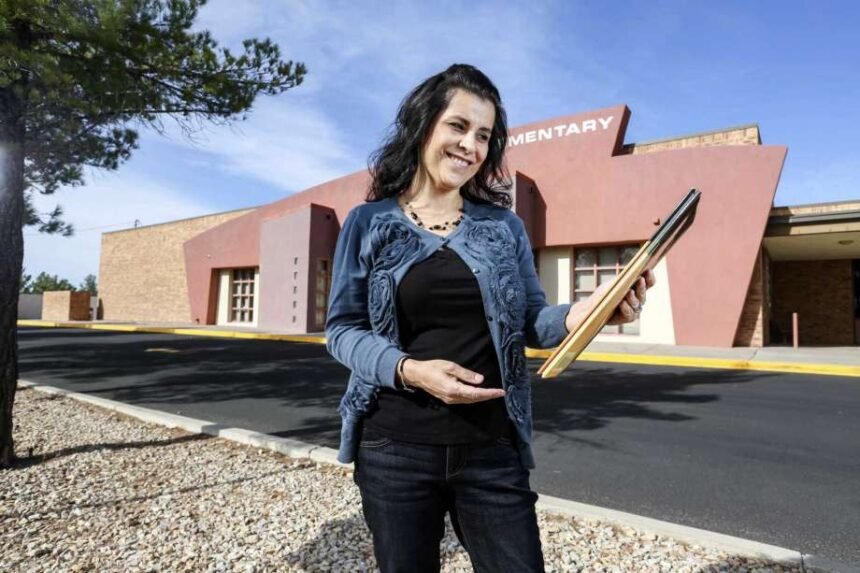Las Cruces kindergarten teacher keeps students motivated online during pandemic

LAS CRUCES, New Mexico (AP) — Suzette Haywood intended to retire from her career as a teacher last year, but when the Covid-19 pandemic caused education to practically be turned upside down, she knew she couldn’t call it quits.
“I didn’t want to end on that kind of a note,” Haywood told the Las Cruces Sun-News. “I did a virtual teaching (last semester), and I thought … ‘I can’t end the career I love like this.‘”
Haywood, 53, has spent her 29 years of teaching between New Mexico, Virginia and Alaska. She began her career in Las Cruces and moved back to her hometown to teach kindergarten at Highland Elementary School this year.
On the final day of class before the Thanksgiving break. Haywood welcomed her students, one by one, into her virtual Zoom classroom and encouraged each student to greet their friends as they entered.
School buildings in Las Cruces Public Schools have been shut down since March as a way to mitigate the spread of the virus. Classes have been virtual ever since.
Monday through Friday, Haywood meets with her class of 19 5-year-olds at 9 a.m. to give them live instruction. The class goes through her presentations, which she prepares daily that remind them of class rules that include: stay muted while Ms. Haywood is talking, no eating, listen closely and be respectful.
Her students enthusiastically participate in each activity.
“They need to know they matter,” Haywood said. “What the kids really, really need (is) to feel valued and loved and validated daily. That’s what they need. They will rise to the occasion. Everything else will fall into place.”
Haywood spends each class using positive reinforcement and gentle guiding to keep her students on track. Common phrases include: “All the smart people are listening.” She said students want to be smart, and using phrases that highlight intelligence motivates students to do what they're told.
“I asked myself at the beginning of every class, would I want to be a student in my room?” Haywood said. “If you can ask yourself that question every day … and you’ve done exactly that — that’s the magic.”
Haywood said she has learned a lot in her years as an educator, but this year truly felt like she was starting all over again because of the online learning model.
“I am a seasoned, tech-savvy teacher, and it’s difficult for me,” Haywood said. “I keep reaching out to my principal friends: if you have a new teacher that’s struggling, please tell them to contact me. I do not mind mentoring, because it makes me stronger and learn this faster … We can learn together.”
Haywood usually starts her day at 6 a.m. to make last-minute preparations for her class, then she works until 9 p.m. creating presentations and lesson plans for the next day.
“I’m working harder now than I have in 29 years, I can tell you that.”
___
Everyone’s learning
Haywood had concerns at the beginning of the year that online learning would lose some of the “magic” that comes with teaching, but she’s since learned that the magic still exists because of the connection she has been able to make with her students.
She said she has been able to foster great relationships with her students’ parents throughout the semester.
”(They’re) my biggest resource right now,” Haywood said. “It’s crazy to think that you could do this job alone right now.”
Haywood has seen many parents helping their children work the virtual classes and appreciates their efforts to help her students learn in this remote environment.
She’s been closely watching which activities spark the most interest and participation and taking note of what factors engage students virtually.
Recently, she began implementing “show me” and “don’t show me” phrases. Her students each have homemade signs with “A” and “B” on them. Haywood would ask the student to “show me” their answer — “A” or “B” — and that method worked well, but then the signs would distract the students. She heard another teacher use the “don’t show me” phrase and now she uses it to help her students stay on topic.
“I haven’t been trained to do this,” Haywood said. “I had to research this on my own because nobody could see what we needed. It was an unknown. It’s uncharted territory for everybody, not just me. I think we’re all grieving a profession that doesn’t really exist anymore. So we have this new normal that we have to figure out how to make it work, because it’s not going anywhere in the near future.”
Haywood hopes her students can learn from the situation caused by the pandemic and look on the bright side.
“I hope they learn to, to embrace the stressors of day-to-day life and just keep moving ahead, regardless of any obstacle that they face,” Haywood said. “They can do it, and it doesn’t matter how many times they fall down. I just want them to realize that they can keep on trying.”
